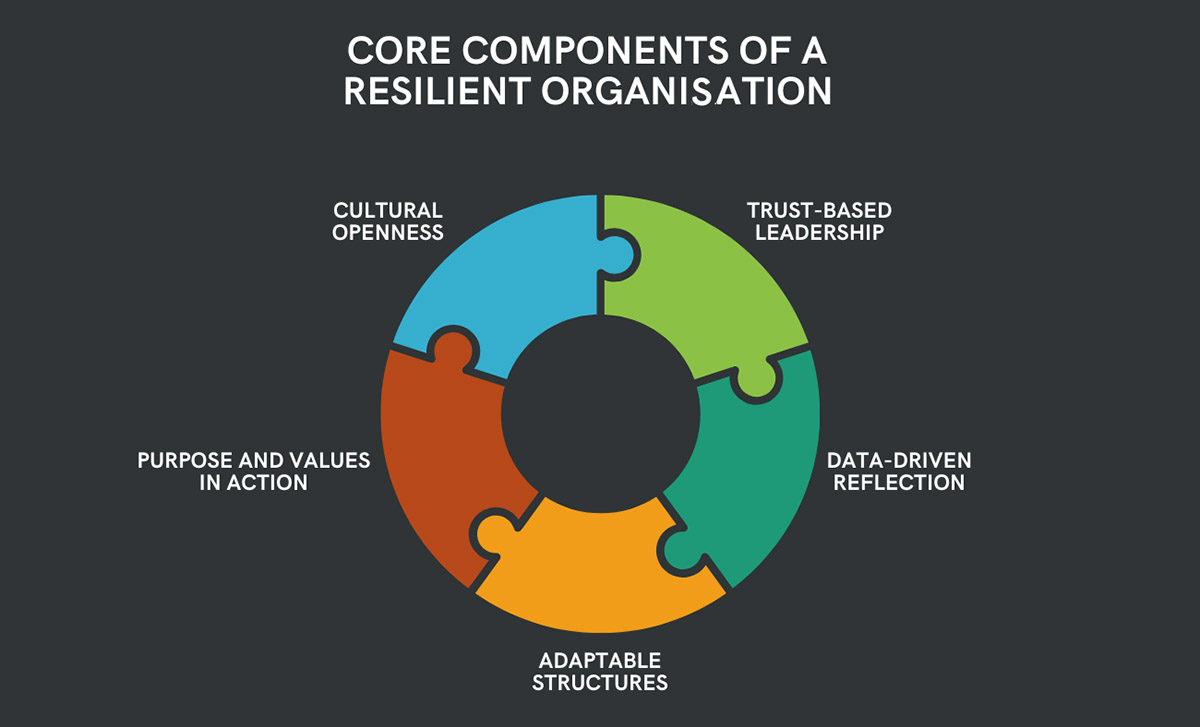The future belongs to resilient organisations
Agile was just the beginning: Why resilient organisations are a strategic necessity
Is “corporate resilience” just another buzzword? Perhaps. But it’s one we would do well to take seriously.
Organisations today are under constant pressure to change. The events of recent years, from the pandemic to geopolitical crises to the disruptive impact of AI and digitalisation, have shown how vulnerable many structures actually are. Companies that had been considered stable for years suddenly became fragile. Employees felt overwhelmed, leadership failed, and well-intentioned agile initiatives fizzled out without effect.
Resilience is often understood as an individual ability. In addition to the original definition, namely the ability to return to one’s original state after stress or even emerge stronger, resilience is often equated with stamina, resilience or adaptability. But that falls short. Because organisations as a whole must also become resilient. Or rather, they must be adaptable, capable of learning and clear in their orientation. This is exactly what I mean when I talk about corporate resilience.
Why classic agility is not enough
Agility was long considered the answer to the VUCA world [1], which was then replaced by the BANI world [2]. But many organisations have failed because of their own agility.
Why? Because agility is not just a question of method. Scrum boards, daily stand-ups and sprints only help if the foundation is right: a sustainable culture in which responsibility is shared, leadership can let go and employees are given creative freedom. This is often where the problem lies. The agile toolbox is introduced, but the mindset remains the same.
Resilient organisations, on the other hand, go one step further. They understand change not as an exceptional situation, but as a permanent state of affairs. In doing so, they create conditions in which teams can not only react, but also proactively shape the future.
What makes an organisation resilient?
Resilient organisations are not simply ‘robust’; they are dynamic. They can withstand tensions, navigate contradictions and realign themselves without losing their identity. Five key characteristics stand out:
1. Cultural openness
A resilient organisation embodies openness not only in its mission statement, but also in its everyday work. Feedback is welcome, criticism is listened to, and psychological safety is the norm.
2. Trust-based leadership
Managers are not controllers, but rather provide guidance and promote self-efficacy. They see themselves as supportive team members, not bosses.
3. Data-based reflection
Resilient organisations do not rely on gut feelings. They use data to visualise culture, collaboration and development. Not for control, but for conscious further development.
4. Adaptable structures
Processes are not set in stone, but are allowed to evolve. The organisation breathes with the market without allowing chaos.
5. Purpose orientation and values
Purpose is not a marketing gimmick. It is the inner compass that is lived out in everyday life. Those who experience purpose stay. Those who feel trust unfold their potential.
Figure 1: Core Components of a resilient organisation
The price of lacking resilience
The opposite of resilience is not just ‘instability’; it is paralysis, disorientation, fluctuation and inner resignation.
We are currently seeing this in many companies:
- Employees are ‘working to rule’ even though they could contribute more.
- Managers are exhausted.
- HR departments are struggling with quiet quitting, high fluctuation and a labour market that is no longer forgiving.
- Processes work on paper, but not in everyday life.
What is missing is genuine innovative strength. Not the ideas, but the breeding ground on which they could grow.
Corporate resilience starts with people
Organisational resilience is not purely a structural issue. It always arises from the people within the organisation, and this is precisely where the decisive lever lies: strengthening employees strengthens the organisation!
This does not mean wellness programmes or fruit baskets. It means creating spaces where people can think for themselves, get involved and learn.
It means not avoiding conflicts, but resolving them respectfully, on an equal footing.
It means training managers who can listen. Managers who see diversity as a strength, who can deal with ambiguity without falling into a control frenzy.
And it means using data to make collaboration and culture visible, beyond subjective impressions or pure KPIs. Because only what is visible can be developed in a targeted manner!
Visibility, data and genuine development
This is a key lever for making sustainable change, culture and collaboration visible and tangible. Not through vague gut feelings or one-off employee surveys, but through precise, scientifically based analyses that make measurable what would otherwise remain hidden. After all, how can we change something we cannot see?
Many organisations rely on mood surveys, feedback sessions or questionnaires, the results of which often come to nothing. What is missing is a common understanding of where the real levers lie and how they change over time. True visibility means not only capturing the mood today, but also uncovering structures and dynamics that have a long-term impact on performance, retention and innovation.
Data creates precisely this visibility. It is not a control instrument, but a differentiated, fact-based and context-sensitive mirror. It helps to identify patterns that are lost in the daily hustle and bustle:
- Where is potential being wasted?
- Where is there psychological uncertainty?
- Where do processes overlap instead of complementing each other?
And they provide managers with tools to not only react, but to proactively shape the future. Those who know where their strengths and risks lie can work on them in a targeted manner. Not through symbolic politics or short-term actionism, but through systemic development across all levels.
Data takes us out of the spiral of interpretation. Away from ‘I think we have a problem’ to ‘we know what we need to work on’. This changes not only conversations, but also decisions. Because when culture, collaboration and willingness to change become visible, development becomes possible.
Conclusion: Resilient organisations and future strength do not arise on their own
Corporate resilience is not a goal that you achieve once and then tick off your list. It is an ongoing process of learning and adaptation. It is not about perfection, but about agility and the courage to constantly question yourself. It is about the ability to balance stability and change.
If you want to remain relevant in five or ten years’ time, you need to invest in resilience today. Not as the next buzzword, but as a strategic necessity.
Resilience means providing guidance instead of rigid control, enabling development instead of mere efficiency, and embracing diversity instead of promoting uniformity. All of this is based on a stable foundation of trust, openness and purpose.
The good news is that resilience can be trained. Organisations can learn to strengthen themselves. Step by step. With clarity, data and genuine dialogue. If you understand this and want to put it into practice, please feel free to contact me at any time. I look forward to discussing this with you and making our companies and our economy resilient.
Notes:
Are you interested in a conversation about agility and resilience in organisations? You can easily contact Vanessa Steffen on LinkedIn.
[1] What is VUCA?
[2] What is BANI?
Would you like to discuss resilient organisations as a multiplier? Then share this post in your network.
Vanessa Steffen has published three more posts on the t2informatik Blog:

Vanessa Steffen
Vanessa Steffen founded Truelutions with the intention of supporting future-oriented companies in the field of agile organisational development and corporate management. In doing so, she brings together the needs of employees and employers while ensuring economic efficiency.
In the t2informatik Blog, we publish articles for people in organisations. For these people, we develop and modernise software. Pragmatic. ✔️ Personal. ✔️ Professional. ✔️ Click here to find out more.



